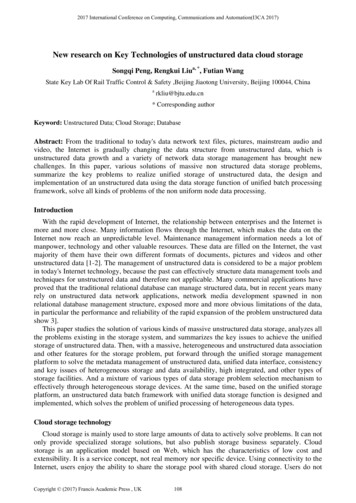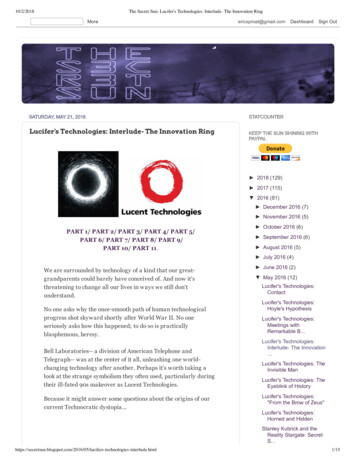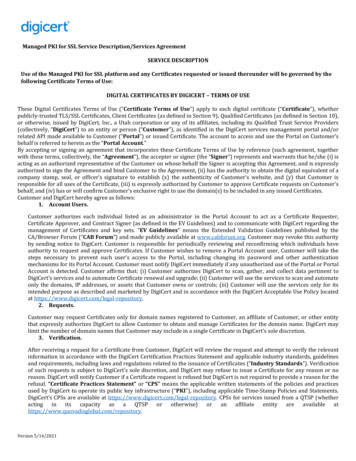
Transcription
2017 International Conference on Computing, Communications and Automation(I3CA 2017)New research on Key Technologies of unstructured data cloud storageSongqi Peng, Rengkui Liua, *, Futian WangState Key Lab Of Rail Traffic Control & Safety ,Beijing Jiaotong University, Beijing 100044, Chinaarkliu@bjtu.edu.cn* Corresponding authorKeyword: Unstructured Data; Cloud Storage; DatabaseAbstract: From the traditional to today's data network text files, pictures, mainstream audio andvideo, the Internet is gradually changing the data structure from unstructured data, which isunstructured data growth and a variety of network data storage management has brought newchallenges. In this paper, various solutions of massive non structured data storage problems,summarize the key problems to realize unified storage of unstructured data, the design andimplementation of an unstructured data using the data storage function of unified batch processingframework, solve all kinds of problems of the non uniform node data processing.IntroductionWith the rapid development of Internet, the relationship between enterprises and the Internet ismore and more close. Many information flows through the Internet, which makes the data on theInternet now reach an unpredictable level. Maintenance management information needs a lot ofmanpower, technology and other valuable resources. These data are filled on the Internet, the vastmajority of them have their own different formats of documents, pictures and videos and otherunstructured data [1-2]. The management of unstructured data is considered to be a major problemin today's Internet technology, because the past can effectively structure data management tools andtechniques for unstructured data and therefore not applicable. Many commercial applications haveproved that the traditional relational database can manage structured data, but in recent years manyrely on unstructured data network applications, network media development spawned in nonrelational database management structure, exposed more and more obvious limitations of the data,in particular the performance and reliability of the rapid expansion of the problem unstructured datashow 3].This paper studies the solution of various kinds of massive unstructured data storage, analyzes allthe problems existing in the storage system, and summarizes the key issues to achieve the unifiedstorage of unstructured data. Then, with a massive, heterogeneous and unstructured data associationand other features for the storage problem, put forward through the unified storage managementplatform to solve the metadata management of unstructured data, unified data interface, consistencyand key issues of heterogeneous storage and data availability, high integrated, and other types ofstorage facilities. And a mixture of various types of data storage problem selection mechanism toeffectively through heterogeneous storage devices. At the same time, based on the unified storageplatform, an unstructured data batch framework with unified data storage function is designed andimplemented, which solves the problem of unified processing of heterogeneous data types.Cloud storage technologyCloud storage is mainly used to store large amounts of data to actively solve problems. It can notonly provide specialized storage solutions, but also publish storage business separately. Cloudstorage is an application model based on Web, which has the characteristics of low cost andextensibility. It is a service concept, not real memory nor specific device. Using connectivity to theInternet, users enjoy the ability to share the storage pool with shared cloud storage. Users do notCopyright (2017) Francis Academic Press , UK108
need to know the contents of the system, do not need to know how to store, it is transparent to allequipment users, at any time and space authorized users can use the network connection to usecloud storage, cloud services 4-5. The cloud storage data architecture model shown in Figure 1.Figure 1. The architecture of cloud data storage service.With the rapid development of modern network information technology, the information data hasincreased exponentially, formed in the era of big data, user generated data stored in the user datastored in the cloud environment has put forward higher requirements that need to be addressed: (1)efficient mass data storage and access requirements, users appear to hundreds of millions ofmonthly the dynamic query SQL data record, billions of dollars in relational database is inefficient,in the era of big data, the urgent need to solve the problem of data storage and efficient access tolarge amounts of data; positive development; (2) high concurrent read and write the database, theInternet network, the key to the user as the center, according to the personalized information theuser needs to generate dynamic pages and information, such as the current micro Bo, this form ofhigh concurrent access load data, usually form each Tens of thousands of seconds to read and writerequirements; (3) high availability and scalability of the database requirements, system structurebased on Web, it is very difficult to extend the database, when the user access to the database serveris increasing rapidly, not simply the use of hardware and service node scalability and load balancing.Provide maintenance, upgrade and migration form stop uninterrupted data for web servicerequirements, will reduce the user experience: C4) support for unstructured data processing needs ofthe port, the relational database greatly limits the data processing and data types, various types ofdata can not be achieved in the future in the user requirements.Unstructured data cloud storage hierarchyThe storage and use of unstructured data is very common. Many systems have to uploadattachments, pictures, press releases and document management functions. At present, however,most implementations are stored by creating a writable directory on the server. Unstructured data isoften larger, requiring more bandwidth and a certain computing power of the server, which hassome impact on some of the server's high performance requirements. Server cluster synchronization.As applications require large-scale cluster support, the traditional approach will face morechallenges. In order to synchronize data between nodes in each server, we need some similarnetwork storage techniques to solve them. Many servers are uploaded to the server side of the TroyTrojan program invasion, most of these implementations because of vulnerability generated byuploading files. The storage requirements of the traditional file system for unstructured data must bethe directory of the filesystem, which is 6-7 writable. Cloud storage is not required, and similarfunctions can be implemented using other methods, but technically advanced cloud storage hassome advantages. Cloud storage is stored and read in the form of object storage, which isresponsible for the actual content of the document. The high scalability, massive, high reliabilityand repeated file merging of cloud storage will help to improve the quality of storage service. Theunstructured data cloud storage architecture is based on this design, as shown in Figure 2.109
Unstructured dataVideo monitoringand data storageMulti-user onlinestorage serviceEnterprise dataservicesSoftware downloadserviceUnstructured dataaccess clusterApplication layerUsermanagementAccessauthorizationBLOB datamanagementSecurity policyMeta datamanagementSession layerData layerRouting layerRelational databasestorage clusterPhysical layerFigure 2. Cloud storage tier architecture of unstructured dataThe application layer provides unstructured data application interface, the interface is composedof various types of data storage service providers to develop the storage applications, such as onlinestorage, network drives, video, data hosting and software download service. At this point, users facea virtual, unlimited capacity cloud storage space without taking into account the physical location ofthe storage space and data when the user submits the data.The session layer is responsible for user management, authority allocation, spatial allocation, andstorage security policies. The layer relies on the security level and develops different securityprograms to ensure data security.The role of data layer is the unified management of unstructured data and metadata. Unstructureddata ranges from MB to GB, and size and metadata information, such as data identifiers, file length,type and other attribute information, the total length of not more than 1 KB, the difference in theamount of data between the two. Therefore, different data and metadata need to be stored on thenetwork bandwidth, and computing resources should be used for different types of data storagestrategies. Thus, figure 1 will be broken down into a data layer, a service data store, and a metadatastore. The routing layer is responsible for cloud nodes, interoperability and storage path accessinterfaces and back-end storage device computing.The physical layer of unstructured data storage provides storage space and computing resources,and is responsible for maintaining physical path storage nodes. The purpose of this system is tomake full use of the existing communication subnet and equipment without adding hardware input.Unstructured data cloud storage system structure designIn order to realize the effective management of unstructured data, many companies andindividuals at home and abroad have done a lot of research. The most important management isdivided into two categories: one is to convert the unstructured data based on the technology of semistructured data; the other is the conversion of unstructured data to structured data, the final data willbe stored in a relational database. Unstructured to structured data conversion mostly adoptsunstructured data, structured data and semi-structured data. Therefore, through the storage andmanagement of relational database, the data structure is obtained. According to the requirements ofthe project, "structured data, unstructured data, semistructured data conversion method andgradually enlarge the application on the basis of the data structure of file metadata extractionconcept structure standard to realize the conversion function of the template file name save theconverted files, create a document template, unstructured data file table and structured dataassociation, as shown in Figure 3 shows. The system is composed of database, file system, templatelibrary, file format definition module, metadata extraction module, template creation andmanagement module, middle module, data representation and data conversion module. The whole110
system is divided into three layers: interface application layer, application logic layer and datastorage layer.File system (client)FTP serverApplication layerinterfaceLocal hostAccess the fileFile format definitionMetadata extractionTemplates create and manageSave templateApplication logiclayerIntermediate data representationTemplate libraryXML data conversionTemplate informationmanagementCreate tablestructureDocumenttemplate tableDocument theresults tableData storage layerFigure 3. Unstructured data cloud storage system structureThe application layer interface provides the user interface graphical data interface of theapplication program, the user can use the structured unstructured data conversion operation,regardless of the specific data conversion.The program logic layer is composed of five functional modules of the system structure, withemphasis on the implementation of the business logic structure to the unstructured data conversionsystem. The application layer interface client file system in the acquisition of analog output file,make a request for data conversion, then the application receives a request sent by the client, willneed to convert the file transfer to the data conversion module. After the module receives the file, itdetermines which program to convert according to the type of file. Then, the work of the fivefunctional modules, file metadata extraction, set up the appropriate document template, and thenrealize unstructured to semi-structured data conversion, the processed data is written in the databasetable simulation results. Then, the application results are converted back to the user, and the user isprompted for the next data conversion, and finally the entire process of data conversion iscompleted.The data storage layer collects the database tables used by the system, such as documenttemplates, document association tables, simulation results tables, and so on. The document templateneeds to create a document association table before the system runs. The data simulation table is theunstructured file data after the structured data is converted. When the data conversion is complete,the system will associate the relevant information to the file table.ConclusionNon structured data analysis based on the rapid growth trend on the Internet, introduces thesolutions proposed by researchers at home and abroad, and non structured data storage, storage ofthese solutions can solve the massive unstructured data, and to ensure that the expansion of thesystem. However, different data types of unstructured data and different data have different storagecharacteristics, and how to store these different types of unstructured data in a unified way becomesan urgent problem.This paper presents a unified unstructured data storage platform, unstructured data storageinterface provides a unified model, combined with the underlying implementation of different typesof unstructured data in heterogeneous storage, and in this heterogeneous storage infrastructure, toensure the consistency of the data and the use of high. On this basis, combining a number ofunstructured data structures on the storage platform, a large number of unstructured data resources111
and storage resources can be fully integrated in the processing process to achieve efficient dataprocessing.AcknowledgementsFund Project: National Natural Science Foundation of China (51578057); State Key Laboratoryof Rail Traffic Control and Safety (Beijing Jiaotong University) Independent research project(RCS2016ZT007) .References[1] Nicolae B. High throughput data-compression for cloud storage[M]//Data Management in Gridand Peer-to-Peer Systems. Springer Berlin Heidelberg, 2010: 1-12.[2] Calder B, Wang J, Ogus A, et al. Windows Azure Storage: a highly available cloud storageservice with strong consistency[C]//Proceedings of the Twenty-Third ACM Symposium onOperating Systems Principles. ACM, 2011: 143-157.[3] Prahlad A, Muller M S, Kottomtharayil R, et al. Performing data storage operations with acloud storage environment, including automatically selecting among multiple cloud storagesites: U.S. Patent Application 12/751,651[P]. 2010-3-31.[4] Zhang D W, Sun F Q, Cheng X, et al. Research on hadoop-based enterprise file cloud storagesystem[C]//Awareness Science and Technology (iCAST), 2011 3rd International Conference on.IEEE, 2011: 434-437.[5] Wang Q, Wang C, Ren K, et al. Enabling public auditability and data dynamics for storagesecurity in cloud computing[J]. Parallel and Distributed Systems, IEEE Transactions on, 2011,22(5): 847-859.[6] Wang C, Ren K, Lou W, et al. Toward publicly auditable secure cloud data storage services[J].Network, IEEE, 2010, 24(4): 19-24.[7] Lin H Y, Tzeng W G. A secure erasure code-based cloud storage system with secure dataforwarding[J]. Parallel and Distributed Systems, IEEE Transactions on, 2012, 23(6): 995-1003.112
Maintenance management information needs a lot of manpower, technology and other valuable resources. These data are filled on the Internet, the vast majority of them have their own different formats of documents, pictures and videos and other unstructured data [12]. The management of unstructured data is considered to be a major problem-











